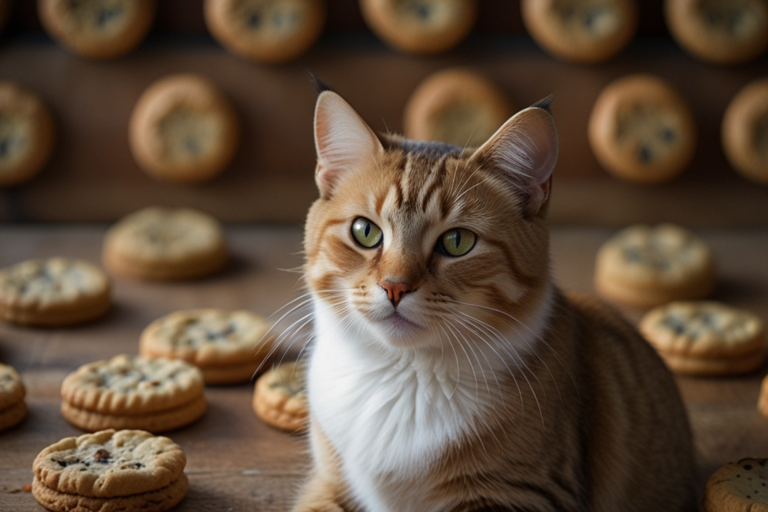
Introduction
Cats are charming creatures that fascinate us with their specific behaviours. Indeed, one of those is ‘Why do cats make biscuits?’ If you’ve ever seen a cat rhythmically kneading its paws on a soft floor, you have witnessed this captivating and mysterious conduct.
But why do cats make cookies? His comprehensive article will explore the origins, meanings, and technology behind this feline dependency. Whether you are a seasoned cat owner or new to the TTom Cats arena, knowing why cats make cookies can deepen your appreciation for these charming animals.
What does “make cookies” suggest?
Before we discuss the reasons for this behavior, let’s clarify the term “making cookies.” When a cat alternately presses its paws into a soft floor, such as a blanket, pillow, or even your lap, it resembles the movement of kneading dough—for this reason, in the term “making cookies.”
The beginnings of biscuit making in cats
Instinctive conduct from Kitten
Nursing Reflex: This conduct originates in kittenhood when kittens knead their mom’s abdomen to stimulate milk waft. This instinctual pressure is profoundly ingrained and regularly carries over into maturity.
Comfort institutions: From the earliest days, kneading has been related to comfort, warm temperatures, and safety.
Evolutionary roots
Territorial marking: Cats have scent glands on their paws. By kneading, they can mark their territory with their particular fragrance.
Habits of untamed ancestors: Wild cats kneaded grass or leaves to make a smooth location to sleep. This conduct could be an evolutionary holdover.
Why do grown-up cats continue to make cookies?
Emotional comfort
Stress alleviation: Kneading can serve as a self-soothing mechanism for cats.
Expressing contentment: Cats regularly knead while comfortable and satisfied, especially while bonding with their humans.
Connection and affection
Signal of trust: When your cat rubs you, it shows belief and affection.
Claiming Ownership: Cats might also bite on you to mark you as a part of their territory.
Preparing an area for relaxation
Instinctive Nesting: Cats may additionally nest to create a snug vicinity to sleep or relax.
Calming: Repetitive motion can mimic the movements of their ancestors to create a secure space.
The technology at the back of making cookies
Neurological connection
Dopamine release: Kneading triggers the discharge of dopamine, a feel-good chemical that calms and relaxes cats.
Muscle memory: The kneading movement has been deeply embedded in the cat’s mind since childhood.
Hormonal effect
Oxytocin Boost: Kneading will increase oxytocin, a hormone associated with bonding and trust.
Release of endorphins: Kneading releases endorphins, reducing stress.
How do cats choose where to make cookies?
Preferred surfaces
Soft materials: Blankets, pillows, and luxurious fabrics are not unusual alternatives.
Warm locations: Cats are attracted to heat regions that offer comfort.
Human wedges and chests
Scent Association: Cats discover your scent comforting and accompany it with protection.
Emotional Bond: Kneading humans is a compelling show of affection and trust.
Should you be worried about kneading conduct?
Normal conduct
AnA innocent dependency: Kneading is ordinary and healthy conduct for maximum cats.
Indicator of nicely-being: Regular kneading frequently shows a satisfied and steady cat.
Signs of strain
Excessive kneading: If your cat kneads obsessively, it could imply anxiety or pressure.
Accompanying Behaviors: Watch for symptoms with immoderate grooming or hiding that might suggest trouble.
How to react while your cat makes cookies
Encouraging conduct
Provide soft surfaces: Offer blankets or pillows to make kneading more excellent and snug.
Positive reinforcement: Gently stroke your cat or communicate soothingly while kneading.
Management of sharp claws
Trim their nails: Trimming their nails often can save you soreness.
Protective covers: Consider using claw covers to keep away from scratching.
When it is inconvenient
Redirect Caution: Offer toys or alternative surfaces for kneading.
Use protective layers: Place a thick blanket over your lap to lessen discomfort.
Frequently asked questions on why cats make cookies.
1. Do all cats make cookies?
Not all cats knead, but it is a commonplace behaviour. Cats who no longer knead may additionally express contentment with other methods.
2. Is kneading particular to home cats?
While it’s more generally seen in domestic cats, wild and feral cats can showcase comparable behaviours.
3. Why does my cat drool when kneading?
Drooling regularly accompanies kneading, a profoundly relaxing and calming movement for cats.
4. Can kneading be a symptom of illness?
Excessive or sudden kneading can sometimes suggest strain or an underlying health problem. If you notice uncommon conduct, seek advice from your veterinarian.
5. Why do cats purr when kneading?
Purring and kneading regularly occur together, as each is a sign and symptom of rest and contentment.
Conclusion: The Magic of Cookie Cats
So why do cats make biscuits? This endearing behavior stems from an aggregate of instinct, comfort, and affection. Whether it’s a return to kittenhood or a manner to reveal acceptance accurately, kneading is a fascinating element of cat behavior that strengthens the bond between cats and their people. Embrace the magic of cookie-making and recognize it as another way your cat communicates love and contentment.


